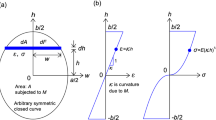Abstract
The concept of the effective length factor represents an important parameter with regard to the elastic buckling analysis. This concept makes possible computational of the elastic critical load using a single formula for any situation of boundary conditions. We noted that substantial research has been done by many researchers in this field. The work developed in this paper, is focused on the resoluteness of the exact value of the effective length factor of columns belonging to unsymmetrical frames, with asymmetrical loading. For this purpose we chose to study an unsymmetrical frames asymmetrically loaded where the geometry and loading are set by means of a great number of a dimensionless parameters. At first, a theoretical approach is adopted to investigate the global elastic buckling of an irregular frame. This is done by considering the classical stability functions which introduce the coupling between axial loading and the bending stiffness of the columns. Thus, the governing equilibrium equations were established for the structure being studied, leading to the global nonlinear stiffness matrix of the structure. Therefore, the global elastic buckling occurs when the determinant of the nonlinear stiffness matrix vanishes. Thereafter, a wide parametrical analysis was done from the theoretical results previously obtained. In determining the effective length factor K, a marked difference was noted between the results obtained using the Eurocode 3 approach and those obtained by the current study.








Similar content being viewed by others
References
Adman, R., & Saidani, M. (2013). Elastic buckling of columns with end restraint effects. Journal of Constructional Steel Research, 87, 1–5.
Aristizabal-Ochoa, J. D. (1994a). K-factor for columns in any type of construction: Nonparadoxical approach. Journal of Structural Engineering, 120(4), 1272–1290.
Aristizabal-Ochoa, J. D. (1994b). Slenderness K factor for leaning columns. Journal of Structural Engineering, 120(10), 2977–2991.
Aristizabal-Ochoa, J. D. (1994c). Stability of columns under uniform axial load with semirigid connections. Journal of Structural Engineering, 120(11), 3212–3222.
Aristizabal-Ochoa, J. D. (1996). Braced, partially braced and unbraced columns: Complete set of classical stability equations. Structural Engineering and Mechanics, 4(4), 365–381.
Aristizábal-Ochoa, J. D. (2002). Classic buckling of three-dimensional multicolumn systems under gravity loads. Journal of Engineering Mechanics, 128(6), 613–624.
Bridge, R. Q., & Fraser, D. J. (1987). Improved G-factor method for evaluating effective lengths of columns. Journal of Structural Engineering, 113(6), 1341–1356.
Cen, E. (2005). 1-1-Eurocode 3: Design of steel structures-part 1-1: General rules and rules for buildings. Brussels: European Committee for Standardization.
Cheong-Siat-Moy, F. (1986). K-factor paradox. Journal of Structural Engineering, 112(8), 1747–1760.
Cheong-Siat-Moy, F. (1999). An improved K-factor formula. Journal of Structural Engineering, 125(2), 169–174.
Gantes, C. J., & Mageirou, G. E. (2005). Improved stiffness distribution factors for evaluation of effective buckling lengths in multi-story sway frames. Engineering Structures, 27(7), 1113–1124.
Girgin, K., Ozmen, G., & Orakdogen, E. (2006). Buckling lengths of irregular frame columns. Journal of Constructional Steel Research, 62(6), 605–613.
Hellesland, J. (2012). Evaluation of effective length formulas and applications in system instability analysis. Engineering Structures, 45, 405–420.
Hellesland, J., & Bjorhovde, R. (1996). Improved frame stability analysis with effective lengths. Journal of Structural Engineering, 122(11), 1275–1283.
Horne, M. (1975). An approximate method for calculating the elastic critical loads of multi-storey plane frames. The Structural Engineer, 53(6), 242–248.
Kalochairetis, K. E., & Gantes, C. J. (2012). Elastic buckling load of multi-story frames consisting of Timoshenko members. Journal of Constructional Steel Research, 71, 231–244.
Kashdan, L., Conner Seepersad, C., Haberman, M., & Wilson, P. S. (2012). Design, fabrication, and evaluation of negative stiffness elements using SLS. Rapid Prototyping Journal, 18(3), 194–200.
Kishi, N., Chen, W.-F., & Goto, Y. (1997). Effective length factor of columns in semirigid and unbraced frames. Journal of Structural Engineering, 123(3), 313–320.
Li, Q., Zou, A., & Zhang, H. (2016). A simplified method for stability analysis of multi-story frames considering vertical interactions between stories. Advances in Structural Engineering, 19(4), 599–610.
Livesley, R. K., & Chandler, D. B. (1956). Stability functions for structural frameworks. Manchester: Manchester University Press.
Load, A. (1999). Resistance factor design (LRFD) specification for structural steel buildings. Chicago: American Institute of Steel Construction Inc.
Mageirou, G. E., & Gantes, C. J. (2006). Buckling strength of multi-story sway, non-sway and partially-sway frames with semi-rigid connections. Journal of Constructional Steel Research, 62(9), 893–905.
Raftoyiannis, I. G. (2005). The effect of semi-rigid joints and an elastic bracing system on the buckling load of simple rectangular steel frames. Journal of Constructional Steel Research, 61(9), 1205–1225.
Teh, L. H., & Gilbert, B. P. (2016). A buckling model for the stability design of steel columns with intermediate gravity loads. Journal of Constructional Steel Research, 117, 243–254.
Webber, A., Orr, J., Shepherd, P., & Crothers, K. (2015). The effective length of columns in multi-storey frames. Engineering Structures, 102, 132–143.
Wood, R. H. (1974). Effective lengths of columns in multi-storey buildings. Building Research Establishment, Building Research Station.
Author information
Authors and Affiliations
Corresponding author
Rights and permissions
About this article
Cite this article
Slimani, A., Ammari, F. & Adman, R. The effective length factor of columns in unsymmetrical frames asymmetrically loaded. Asian J Civ Eng 19, 487–499 (2018). https://doi.org/10.1007/s42107-018-0038-z
Received:
Accepted:
Published:
Issue Date:
DOI: https://doi.org/10.1007/s42107-018-0038-z



